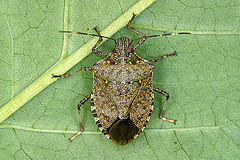LANSING, Mich. — The Michigan Department of Agriculture has confirmed the presence of brown marmorated stink bug, Halyomorpha halys, in Michigan. This is the first confirmation of this pest in the state.
The identity of two specimens — one from Berrien County and the other from Eaton County — were collected by Michigan State University students and verified by USDA entomologists in late January.
The brown marmorated stink bug can be a serious pest of a variety of fruits, vegetables, field crops, and ornamental plants. In its native range, it feeds on a wide variety of host plants. It has also been reported on many ornamental plants, weeds, soybeans and beans for human consumption.
Feeding on tree fruits such as apple results in a characteristic distortion referred to as “cat facing,” that renders the fruit unmarketable as a fresh product.
Keith Creagh, Michigan Department of Agriculture director, said the department and Michigan State University researchers are working to both identify control recommendations and monitor the pest’s spread.
Not typical stink bug
Brown marmorated stink bug is native to eastern Asia and was first discovered in the U.S. in Allentown, Pa., in 1998. Since then, it has spread quickly and now inhabits most eastern states, as well as California and Oregon.
The brown marmorated stink bug superficially resembles several common species of stink bug native to Michigan. Stink bugs can also be a significant indoor nuisance, entering homes in large numbers in the fall in search of protected overwintering sites.
Appearance
Adults are approximately 17 millimeters long and are shades of brown on both the upper and lower body surfaces. They are the typical “shield” shape of other stink bugs, almost as wide as they are long.
To distinguish them from other stink bugs, look for lighter bands on the antennae and darker bands on the membranous, overlapping part at the rear of the front pair of wings. They have patches of coppery or bluish-metallic colored punctures (small rounded depressions) on the head and pronotum.
The name “stink bug” refers to the scent glands located on the dorsal surface of the abdomen and the underside of the thorax.
“Currently, the best available method for controlling BMSB indoors is by sealing entry points like cracks around window and door trim, exhaust vents, air conditioners, ceiling fixtures, etc.,” said Gina Davis, acting director, MDA Pesticide and Plant Pest Management Division. “Once they’ve gained entry, vacuuming live and dead bugs is the best option.
“Pesticide treatments are not recommended because they will not prevent additional invasions.”










